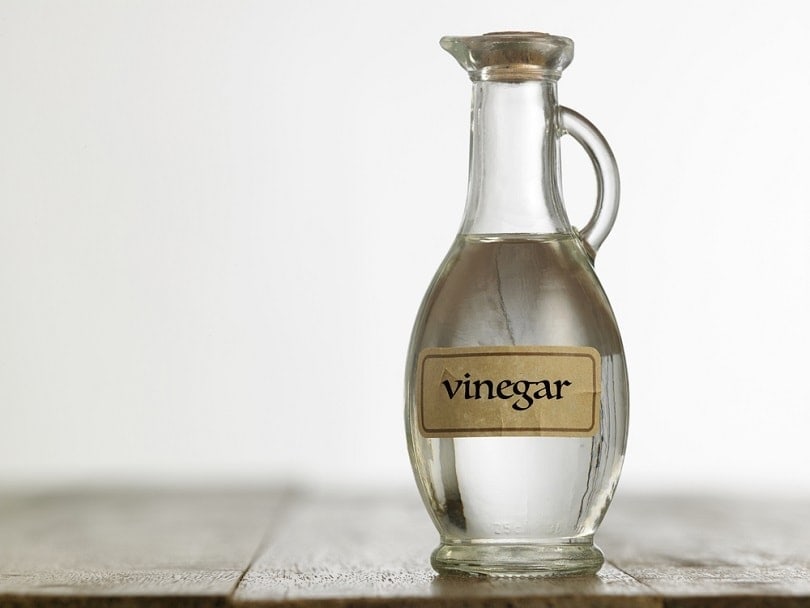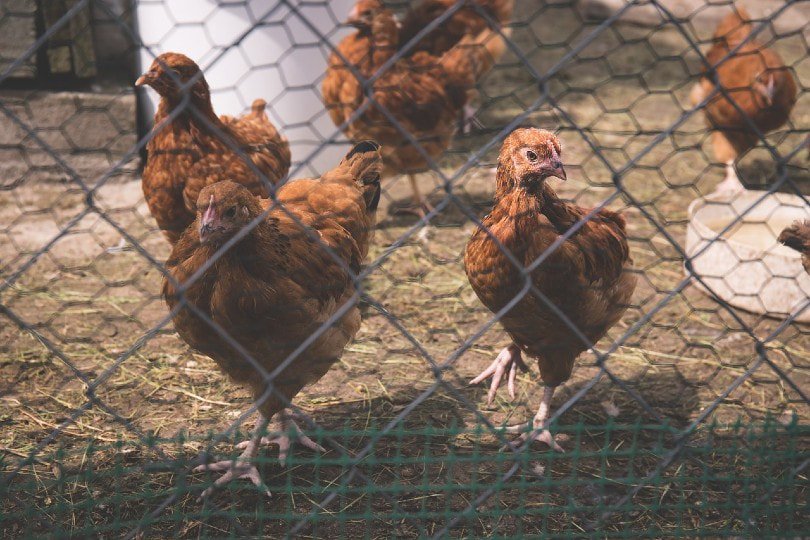If you raise chickens in your backyard, you already know the joy of getting fresh eggs every morning! But unfortunately, you are probably also familiar with the loathsome little intruders that embed themselves in the plumage of your beloved Galliformes.
Thus, it is necessary to know the parasitic risks and, therefore, the prevention to be carried out to have good eggs laid by healthy hens. Here are nine natural ways to get rid of chicken mites and lice, along with some other information you may find useful for the well-being and maintenance of your birds.

The 9 Natural Ways to Get Rid of Chicken Mites & Lice
1. Clean Your Chicken Coop Thoroughly
Ditch the idea that a single sweep will be enough – you’ll have to clean up your chicken coop thoroughly! Move your hens to a pen or other hen house (even a small one, this is temporary) separate from the one to be treated. Disassemble all the elements that can be to disinfect everything. Scour every crack, every nook, every strip of metal or wood.
2. Use Diatomaceous Earth
Diatomaceous earth (DE) is undoubtedly THE natural solution per excellence and quickly becomes essential in the care and hygiene of your hens. Well known in organic farming, diatomaceous earth is indeed a natural pest control. It is effective in the fight against fleas, lice, ticks, and mites: it is, therefore, a natural insecticide with multiple uses.
It comes in the form of a fine powder. Its composition comes from fossilized micro-skeletons of algae called diatoms. It comes in the form of a white or gray powder. In fact, when viewed under a microscope, diatomaceous earth looks like tiny shards of glass.
You just need to sprinkle your chickens with the powder and rub their plumage well. To work optimally, the DE must come into contact with the birds’ skin. And as with every powder treatment, take care to protect your pets’ eyes. Spread it all over the coop: floor, perches, beams, and more. Since it is abrasive, it will destroy the shell of the parasites that will try to find their way there.
However, be careful: although natural, diatomaceous earth is nonetheless abrasive and can cause respiratory problems in some people. You should handle it with care, by wearing a mask and gloves. And as your hens will dispense it, it will then be necessary to spread it regularly.
3. Release a Predatory Mite into Your Chicken Coop

Rather than using chemicals, get into the biological fight against those ugly mites and lice. Indeed, there is an ecological and effective solution to treat these lice with a predatory mite released in the coop: Androlaelaps casalis.
It is in fact another mite, which you can find almost everywhere in the natural state where it can find its prey, namely in bird nests, burrows, food stocks, etc. And if you live in Europe, you can even buy it online.
Moreover, predatory mites have no interest in people or animals; therefore, they will destroy the pest and leave your chickens alone. Besides red mites in poultry, this predatory mite also feeds on tick larvae (and that’s good for you and your other pets).
4. Spray Some Neem Oil
The powerful biological action of neem oil helps control over 400 species of insect pests, including mites and other lice that affect your chickens. Moreover, the systemic action provides preventive control against potential future attacks by mites.
Neem oil is biodegradable, does not create resistance in insects, and is very economical. Also usable in organic farming, horticulture, market gardening, gardening, neem oil is ecological for animals and nature, while being non-toxic to humans, animals, and beneficial insects. Besides, with just one liter of oil, you get about 50 liters of spray.
- Buy a small bottle of neem oil. You can find it at most garden stores. Get a spray bottle and clean it thoroughly.
- Prime the spray solution. To do this, pour in the spray bottle a tablespoon of neem oil per two liters of water.
- Spray the mixture. Do this in the hen house and on the chickens to get rid of mites.
5. Give A Dust Bath to Your Chickens
As an experienced poultry farmer, you probably know that your hens love to roll around in the dust! Dust baths have unexpected benefits. They help your poultry fight against parasite invasions. So do not hesitate to add diatomaceous earth in these strategic places. They will clean their plumage from top to bottom and gain great benefits!
6. Burn It All
Straw or litter should be completely removed and destroyed by fire. If you make a pile somewhere in the garden, the mites will eventually spread again. In addition, this parasite can survive for months without feeding. You, therefore, have no choice but to burn the straw to destroy the louse in all its forms: adults, larvae, eggs, and nymphs.
See also: 10 Best Organic Chicken Feeds – Reviews & Top Picks!
7. Sprinkle Your Chickens with Garlic
Garlic isn’t just for enjoying delicious oven-roasted chicken! It also has anti-mites and lice properties which help control the spread of these tiny vampires.
Be careful, however, not to feed your chickens garlic. Although the information found on the internet tends to be contradictory regarding birds and garlic, PetMD mentions that garlic can be toxic to birds: “Garlic contains allicin, another chemical that can cause anemia and weakness in birds.” In any case, consult your veterinarian before using this food.
8. Use Wood Ash
If you have a fireplace or woodstove, save your ashes. Indeed, wood ash has an abrasive effect that damages the shell of red lice and other mites. It’s not the most radical technique, but it’s natural and safe for your pets.
You can spread ash twice a week on the ground and around the nesting boxes; this will prevent parasites from spreading everywhere.
Besides, be generous when you spread the ash: the hens will scramble there happily to clean themselves and get rid of all those nasty bugs.
9. Make White Vinegar Your Best Friend

Well-known for its cleaning and disinfecting properties including at home, white vinegar can be used to disinfect feeders, bowls, and waterers of the coop.
It is not the most effective solution, but white vinegar repels dust mites, bacteria, and parasites. It can be used as an alternative from time to time so as not to always expose the lice to the same treatments and create resistance.
The other advantage is that it is not toxic or harmful to birds. So, occasionally, you can spray a mixture of water and white vinegar on the legs and the plumage of the hens.
See also: 10 Best Chicken Roosting Bars – Reviews & Top Picks!

Bonus: What Are Red Mites?
The red louse (Dermanyssus gallinae) is a blood-sucking mite attacking birds, and particularly fond of chickens. Its proliferation occurs during hot periods of the year when the reproductive cycle is racing: the 200 to 300 eggs laid each week become adults in seven days. Their bite causes anemia and therefore a drop in immune defenses which makes chickens more susceptible to infections and diseases. The unpleasant itching also disturbs their sleep and generates significant stress. Red mites are also vectors of bacterial or viral diseases such as salmonellosis.
What Conditions Favor the Infestation of Red Mites?
Red mites can lie in the shade for up to nine months while they wait for the right conditions to return – heat and humidity. Fearing the light, the red louse attacks its victim at night and takes refuge during the day in tiny dark recesses that make it difficult to detect. If you see them during the day, the infestation is significant and urgent action is needed. These nasty blood-suckers form agglomerates, traces of which you can find in the interstices of planks, perches, straw, doorways, in the roof, or under the bin. You can also spot their droppings that look like gray and white wildfire or notice blood-soaked red lice in hen droppings.

How To Prevent the Return of Lice and Mites?
- Clean your coop regularly. Collect chicken droppings, remove the soiled straw, and put in a clean litter. A few minutes a day is enough to minimize the risk of diseases and parasites.
- Lice and mites like to take refuge and reproduce in the slats and other interstices of wooden henhouses. An alternative is to equip yourself with a plastic chicken coop, which is less conducive to the development of these disgusting insects.

Final Thoughts
Lice and mites are tiny, blood-hungry creatures that are especially fond of chickens. Fortunately, there are simple, natural, and effective solutions to overcome it. Regular cleaning of the chicken coop is still the most effective weapon, but if you notice an infestation in your chickens, stay calm and use one or a combination of the solutions presented in this article. Your veterinarian will also be of great help in treating the symptoms of infected chickens.
See also:
- How Long Can a Chicken Survive Without Its Head?
- 8 Best Chicken Feeders to Prevent waste – Reviews & Top Picks
- 10 Best Organic Chicken Feeds – Reviews & Top Picks!
Featured Image Credit: StockSnap, Pixabay
